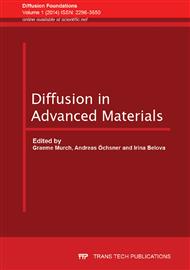p.3
p.31
p.49
p.61
p.77
p.99
p.125
p.155
A Morphology of Diffusion Zone from Entropy Production Calculations
Abstract:
Interdiffusion plays a significant role in the formation and stability of metallic joints and coatings. It is also of critical importance in designing advanced materials. Because commercial alloys are usually multicomponent, the key target is prediction of a complex morphology of the diffusion zone which grows between the alloys, alloy-coating, etc. In a two-component system, the diffusion zone can be composed of single-phase layers of the intermetallic compounds and solid solutions. The evolution of the composition and thicknesses of such layers are fairly well understood and consistent with the phase diagrams. The situation is qualitatively different in multicomponent systems. For example, the diffusion zone in a ternary system can be composed of single-and two-phase sublayers. Their number and thicknesses depend on the initial conditions, i.e. composition, component diffusivities and geometry of the system. The usual way of presenting the sequence of the layers and their compositions is by drawing a diffusion path which is, by definition, a mapping of the stationary concentrations onto the isothermal section of the equilibrium phase diagram. The diffusion path connects initial compositions of the diffusion couple and can go across the single-, two-and three-phase fields. It starts at the composition of one alloy and ends at the other. The possibility of mapping the concentration profiles onto the ternary isotherm has been postulated in one from the seventeen theorems by Kirkaldy and Brown [] for the diffusion path. The detailed presentation of all theorems was recently done by Morral []. Here we remind the reader only of the chosen ones (shown in italics).
Info:
Periodical:
Pages:
31-45
Citation:
Online since:
April 2014
Authors:
Keywords:
Price:
Сopyright:
© 2014 Trans Tech Publications Ltd. All Rights Reserved
Share:
Citation:


